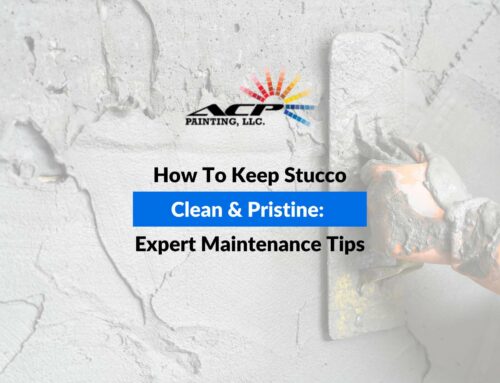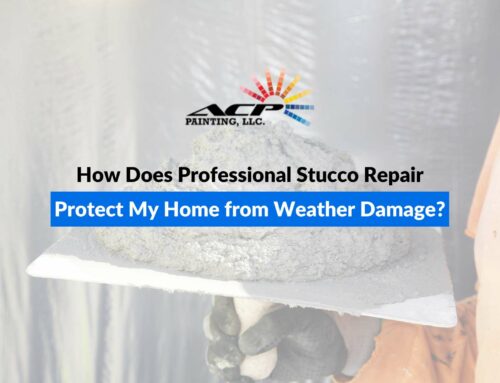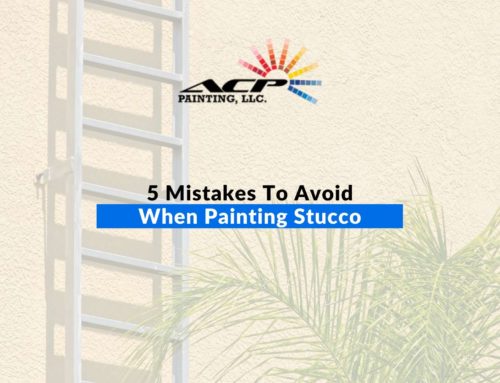Stucco is a very popular siding material in dry, hot climates. It is commonly used on homes throughout the Southwest because it can withstand the heat better than other materials, like wood, which would dry out quickly. Stucco is a great insulator and keeps the inside of the home cooler, even in the hottest temperatures.
What Is Stucco Siding?
Stucco is made of cement, sand, lime, and water. When used as exterior siding, it is applied in three coats over a lath base. It provides a solid, durable, and seamless home exterior which has a natural resistance to fire, long-lasting durability, and requires low maintenance.
Stucco will need some care and attention in order to keep it looking its best. Occasional painting is necessary for aesthetics, as well as preserving and protecting the surface. Here are some tips to get the best results when painting stucco.
1. Inspection. Check out the surface for cracks and other imperfections. Is the stucco peeling in areas?
2. Repair. Fill in any cracks with acrylic caulk. Small areas can be fixed using a pre-mixed stucco repair patch material or kit. You can also buy the ingredients to make your own repair mix. Let dry completely.
3. Clean. The walls will have accumulated dirt and dust, so they’ll need to be cleaned before painting. You can do this with a broom or brush, but most professionals use a pressure washer. Make sure to use the low setting on the washer to prevent damage to the surface. Wash from the top to the bottom so that the dirt is all running off. Stucco is a very porous material and will absorb the water, so make sure to let it dry completely.
4. Remove Mold. Mold can grow on walls quickly and must be removed prior to painting. Sponge the moldy area with a mold removal solution you can buy at any department store. Follow the directions to remove the mold.
5. Prime. A good primer is necessary to make sure the paint adheres to the surface and lasts longer. Apply a high-quality acrylic primer using a roller with a thick nap to get into all the nooks and crannies of the surface. (If your stucco is stained, there are stain-blocking primers available.) You’ll also need a good synthetic brush for the corners and edges.
A good rule of thumb is that two think coats are better than one thick one. Because of the texture of stucco, you don’t want paint pooling in the crevices. Again, allow ample time between coats to dry and before proceeding to the next step.
6. Paint! Finally, you’re ready to apply the paint. Acrylic latex paint works the best on stucco. The amount of paint you’ll need to paint stucco will be more than what the paint can estimates. Because of the texture and porousness of stucco, you’ll need to double the amount of paint you’d buy for a flat surface.
Use the same type of thick-nap roller and brush as you did applying the primer to paint the stucco surface. If you’re comfortable with it, a paint sprayer can also be used. You will probably need an extension pole to reach the higher areas of the house. You may need a second coat of paint but take care to allow sufficient drying time between coats.
As with any paint job, don’t forget the initial step of covering up areas where you don’t want the paint to drip. You’ll need to protect landscaping with tarps or plastic sheeting, and tape off windows, doors, and trim.
Then there’s the cleanup. Because of the criticality of making sure the surface is completely dry after every step, the duration of the project can take days. You’ll need to clean your brushes, rollers, and other tools after each application. When the project is finished, you’ll need to remove all tarps and tape and put away all materials.
Materials Needed to Paint Stucco
Depending on your method of cleaning and painting, you’ll need the following supplies on hand to complete the stucco painting project.
- Broom or pressure washer
- Masonry compatible caulking
- Stucco repair mix (optional)
- Putty knife
- Painter’s tape
- Masonry primer
- Masonry paint
- 5-gallon plastic bucket
- Roller grid
- Paint roller cage with extension pole
- Large-nap paint roller
- Paintbrush
- Spray rig (optional)
Why Not Just Hire an Expert Stucco Painter?
After reading these tips and the effort involved in achieving the best results, aren’t you already exhausted? Wouldn’t you rather be doing something you enjoy than spending days painting?
ACP Painting can take it on for you! We have many years of experience repairing and painting stucco. We also have all the tools and equipment needed, so you don’t have to buy or rent them. Hire us for the job and you’ll get great results that will last you 15-20 years.



